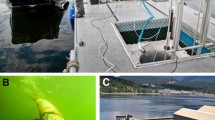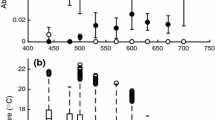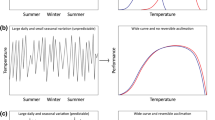Abstract
Thermoregulation could represent a significant fraction of the total energy budget of endotherms under unfavourable environmental conditions. This cost affects several traits of the ecology of an organism such as its behaviour, distribution, or life history. Heat produced by muscle contraction during activity can be used to pay for heat loss or thermoregulation in many species (known as “thermal substitution”). This study seeks to unite the effects of temperature, depth, and activity on the energetic costs of endotherm divers using the Magellanic penguin as model species and to evaluate whether penguins may benefit from thermal substitution. This species operates under highly variable temperature and depth conditions along its breeding range and provides an ideal natural experiment. A developed thermodynamic model describing foraging activity predicted that the major element affecting heat loss was depth, exacerbated by temperature. Birds living in colder waters are predicted to be able to minimize costs by executing shallower dives and benefit from thermal substitution by swimming faster, particularly during deeper dives. The model was evaluated in two contrasting scenarios: (1) when birds swim near the surface commuting to the foraging areas and (2) when birds dive to depth to forage. Activity data from tags on free-living penguins indicated two of these predictions were apparent; penguins generally travelled faster while commuting at the surface in colder waters, while birds from warmer water colonies dived deeper while foraging. Contrary to predictions, however, penguins swam slower at deeper depths during both descent and ascent phases of foraging dives. These results suggest that penguins may benefit from thermal substitution by swimming faster when birds perform shallow dives commuting to and back from foraging areas, but they provide no evidence of behavioural response (via swimming faster) for thermoregulation when diving to depth to forage. Reasons for this are discussed and include the relevance of prey abundance in 3-d space and maximizing dive duration by conserving oxygen reserves. The way the bird operates will have profound consequences for the energy needed and therefore necessary energy acquisition rates. Expansion of our findings to other diving endotherms might help explain both global activity patterns and energy flow in ecosystems.





Similar content being viewed by others
References
Angilletta MJ, Steury TD, Sears MW (2004) Temperature, growth rate, and body size in ectotherms: fitting pieces of a life-history puzzle. Intregr Comp Biol 44:498–509
Bannasch R, Wilson RP, Culik B (1994) Hydrodynamic aspects of design and attachment of a back-mounted device in penguins. J Exp Biol 194(1):83–96
Baudinette R, Gill P (1985) The energetics of flying and paddling in water: locomotion in penguins and ducks. J Comp Physiol B Biochem Syst Environ Physiol 155:373–380
Bevan R, Boyd I, Butler P, Reid K, Woakes A, Croxall J (1997) Heart rates and abdominal temperatures of free-ranging South Georgian shags, Phalacrocorax georgianus. J Exp Biol 200:661–675
Boersma PD, Rebstock GA, Frere E, Moore SE (2009) Following the fish: penguins and productivity in the South Atlantic. Ecol Monogr 79:59–76
Boyd IL (2002) Estimating food consumption of marine predators: Antarctic fur seals and macaroni penguins. J Appl Ecol 39:103–119
Brody S (1945) Bioenergetics and growth. Reinhold, New York
Brown JH, Gillooly JF, Allen AP, Savage VM, West GB (2004) Toward a metabolic theory of ecology. Ecology 85:1771–1789
Buckley LB, Hurlbert AH, Jetz W (2012) Broad-scale ecological implications of ectothermy and endothermy in changing environments. Glob Ecol Biogeogr 21:873–885
Butler PJ, Jones DR (1997) Physiology of diving of birds and mammals. Physiol Rev 77:837
Casarsa L (2005) Morfología y comportamiento de los cardúmenes de sardina fueguina (Sprattus fuegensis) en dos sectores característicos del Atlántico Sudoccidental. Bachellor thesis, Mar del Plata
Ciancio EJ, Botto F, Frere E (2015) Combining a geographic information system, dietary and habitat preferences, and stable isotope analysis to infer Magellanic Penguin diet in their austral distribution. Emu. doi:10.1071/MU14032_AC
Culik B, Wilson R (1991) Energetics of under-water swimming in Adelie penguins (Pygoscelis adeliae). J Comp Physiol B 161:285–291
Culik BM, Wilson RP (1992) Field metabolic rates of instrumented Adélie penguins using double-labelled water. J Comp Physiol B Biochem Syst Environ Physiol 162:567–573
Culik B, Wilson R, Bannasch R (1994) Underwater swimming at low energetic cost by Pygoscelid Penguins. J Exp Biol 197:65–78
Culik BM, Putz K, Wilson RP, Allers D, Lage J, Bost CA, Le Maho Y (1996) Diving energetics in king penguins (Aptenodytes patagonicus). J Exp Biol 199:973–983
De Vries J, Van Eerden MR (1995) Thermal conductance in aquatic birds in relation to the degree of water contact, body mass, and body fat: energetic implications of living in a strong cooling environment. Physiol Zool 68:1143–1163
Enstipp MR, Grémillet D, Jones DR (2006) The effects of depth, temperature and food ingestion on the foraging energetics of a diving endotherm, the double-crested cormorant (Phalacrocorax auritus). J Exp Biol 209:845–859
Fahlman A, Schmidt A, Handrich Y, Woakes AJ, Butler PJ (2005) Metabolism and thermoregulation during fasting in king penguins, Aptenodytes patagonicus, in air and water. Am J Physiol Regul Integr Comp Physiol 289:670–679
Fort J, Porter WP, Grémillet D (2009) Thermodynamic modelling predicts energetic bottleneck for seabirds wintering in the northwest Atlantic. J Exp Biol 212:2483–2490
Frere E, Gandini P, Lichstein V (1996) Variación latitudinal en la dieta del Pinguino de Magallanes Spheniscus magellanicus. Ornitología Neotropical 7:35–41
Gaesser GA, Brooks GA (1975) Muscular efficiency during steady-rate exercise: effects of speed and work rate. J Appl Physiol 38:1132–1139
Garthe S, Ludynia K, Hüppop O, Kubetzki U, Meraz J, Furness R (2012) Energy budgets reveal equal benefits of varied migration strategies in northern gannets. Mar Biol 159:1907–1915
Grémillet D, Boulinier T (2009) Spatial ecology and conservation of seabirds facing global climate change: a review. Mar Ecol Prog Ser 391:121–137
Grémillet D, Tuschy I, Kierspel M (1998) Body temperature and insulation in diving great cormorants and European shags. Funct Ecol 12:386–394
Groscolas R (1986) Changes in body mass, body temperature and plasma fuel levels during the natural breeding fast in male and female emperor penguins Aptenodytes forsteri. Comp Biochem Physiol B 156(4):521–527
Handrich Y, Bevan RM, Charrassin JB, Butler PJ, Ptz K, Woakes AJ, Lage J, Maho YL (1997) Hypothermia in foraging king penguins. Nature 388:64–67
Hansen JE, Martos P, Madirolas A (2001) Relationship between spatial distribution of the Patagonian stock of Argentine anchovy, Engraulis anchoita, and sea temperatures during late spring to early summer. Fish Oceanogr 10:193–206
Hilborn R, Mangel M (1997) The ecological detective: confronting models with data. Princeton University Press, New Jersey
Hind AT, Gurney WS (1997) The metabolic cost of swimming in marine homeotherms. J Exp Biol 200:531–542
Hinke J, Trivelpiece W (2011) Daily activity and minimum food requirements during winter for gentoo penguins (Pygoscelis papua) in the South Shetland Islands, Antarctica. Polar Biol 34:1579–1590
Hudson DM, Bernstein MH (1981) Temperature regulation and heat balance in flying white-necked ravens, Corvus cryptoleucus. J Exp Biol 90(1):267–281
Humphries MM, Careau V (2011) Heat for nothing or activity for free? Evidence and implications of activity-thermoregulatory heat substitution. Intregr Comp Biol 51:419–431
Humphries MM, McCann KS (2014) Metabolic ecology. J Anim Ecol 83:7–19
Kaseloo PA, Lovvorn JR (2005) Effects of surface activity patterns and dive depth on thermal substitution in fasted and fed lesser scaup (Aythya affinis) ducks. Can J Zool 83:301–311
Kaseloo P, Lovvorn J (2006) Substitution of heat from exercise and digestion by ducks diving for mussels at varying depths and temperatures. J Comp Physiol B Biochem Syst Envir Physiol 176:265–275
Kojeszewski T, Fish FE (2007) Swimming kinematics of the Florida manatee (Trichechus manatus latirostris): hydrodynamic analysis of an undulatory mammalian swimmer. J Exp Biol 210:2411–2418
Kooyman GL, Gentry RL, Bergman WP, Hammel HT (1976) Heat loss in penguins during immersion and compression. Comp Biochem Physiol A Comp Physiol 54:75–80
Kvadsheim PH, Folkow LP, Blix AS (2005) Inhibition of shivering in hypothermic seals during diving. Am J Physiol-Regul Integr Comp Physiol 289:326–331
Kvist A, Lindstrom A, Green M, Piersma T, Visser GH (2001) Carrying large fuel loads during sustained bird flight is cheaper than expected. Nature 413:730–732
Le Maho Y (1977) The emperor penguin: a strategy to live and breed in the cold: morphology, physiology, ecology, and behavior distinguish the polar emperor penguin from other penguin species, particularly from its close relative, the king penguin. Am Sci 65:680–693
Liwanag HEM, Williams TM, Costa DP, Kanatous SB, Davis RW, Boyd IL (2009) The effects of water temperature on the energetic costs of juvenile and adult California sea lions (Zalophus californianus): the importance of skeletal muscle thermogenesis for thermal balance. J Exp Biol 212:3977–3984
Lovvorn JR (2007) Thermal substitution and aerobic efficiency: measuring and predicting effects of heat balance on endotherm diving energetics. Philos Trans R Soc Lond B Biol Sci 362:2079–2093
Luna-Jorquera G, Culik BM (2000) Metabolic rates of swimming Humboldt penguins. Mar Ecol Prog Ser 203:301–309
Luque S (2007) Diving behaviour analysis in R. R News 7:8–15
McCafferty DJ, Moncrieff JB, Taylor IR (1997) The effect of wind speed and wetting on thermal resistance of the barn owl (Tyto alba). I: total heat loss, boundary layer and total resistance. J Therm Biol 22:253–264
McCue MD (2006) Specific dynamic action: a century of investigation. Comp Biochem Physiol Part A Mol Integr Physiol 144:381–394
Mcnab BK (2002) The physiological ecology of vertebrates: a view from energetics. Cornell University Press, New York
McNamara J, Ekman J, Houston IA (2004) The effect of thermoregulatory substitution on optimal energy reserves of small birds in winter. Oikos 105:192–196
Mitchell JW (1976) Heat transfer from spheres and other animal forms. Biophys J 16:561–569
Peters G (1997) Die Regulation der Verdauugsprozesse bei Pinguinen (Spheniscidae). PhD thesis. Christian-Albrechts University Kiel
Pinheiro JC, Bates DM (2001) Mixed-effects models in S and S-PLUS. Springer, New York
Ponganis P, Van Dam R, Knower T, Levenson D (2001) Temperature regulation in emperor penguins foraging under sea ice. Comp Biochem Physiol A Comp Physiol 129:811–820
Ponganis PJ, Van RP, Levenson DH, Knower T, Ponganis KV, Marshall G (2003) Regional heterothermy and conservation of core temperature in emperor penguins diving under sea ice. Comp Biochem Physiol A Comp Physiol 135:477–487
Porter WP, Gates DM (1969) Thermodynamic equilibria of animals with environment. Ecol Monogr 39:227–244
Porter WP, Vakharia N, Klousie WD, Duffy D (2006) Po’ouli landscape bioinformatics models predict energetics, behavior, diets, and distribution on Maui. Intregr Comp Biol 46:1143–1158
Prinzinger R, Pressmar A, Schleucher E (1991) Body temperature in birds. Comp Biochem Physiol A Comp Physiol 99:499–506
R Development Core Team (2011) R: a language and environment for statistical computing. In: Computing RFfS (ed), Vienna, Austria
Richman SE, Lovvorn JR (2011) Effects of air and water temperatures on resting metabolism of auklets and other diving birds. Physiol Biochem Zool 84:316–332
Sala JE, Wilson RP, Frere E, Quintana F (2012) Foraging effort in Magellanic penguins in coastal Patagonia, Argentina. Mar Ecol Prog Ser 464:273–287
Schiavini A, Yorio P, Gandini P, Raya Rey A, Boersma D (2005) Los pingüinos de las costas argentinas: estado y Conservación. El Hornero 20(1):5–23
Schmidt Nielsen K (1997) Animal physiology: adaptation and environment. Cambridge University Press, Cambridge
Schmidt A, Alard F, Handrich Y (2006) Changes in body temperatures in king penguins at sea: the result of fine adjustments in peripheral heat loss? Am J Physiol-Regul Integrat Comp Physiol 291:608–618
Scolaro JA, Wilson RP, Laurenti S, Kierspel M, Gallelli H, Upton J (1999) Feeding preferences of the Magellanic Penguin over its breeding range in Argentina. Waterbirds 22:104–110
Sparling CE, Fedak MA, Thompson D (2007) Eat now, pay later? Evidence of deferred food-processing costs in diving seals. Biol Lett 3:95–99
Speakman JR, Król E (2010) Maximal heat dissipation capacity and hyperthermia risk: neglected key factors in the ecology of endotherms. J Anim Ecol 79:726–746
Stahel C, Nicol S (1982) Temperature regulation in the little penguin, Eudyptula minor, in air and water. J Comp Physiol B Biochem Syst Environ Physiol 148:93–100
Takahashi A, Dunn MJ, Trathan PN, Croxall JP, Wilson RP, Sato K, Naito Y (2004) Krill-feeding behaviour in a chinstrap penguin compared to fish-eating in Magellanic penguins: a pilot study. Mar Ornithol 32:47–54
Tucker VA (1975) The energetic cost of moving about: walking and running are extremely inefficient forms of locomotion. Much greater efficiency is achieved by birds, fishes and bicyclists. Am Sci 63:413–419
Walsberg GE, King J (1978) The relationship of the external surface area of birds to skin surface area and body mass. J Exp Biol 76(1):185–189
Williams TD (1995) The penguins: Spheniscidae. In: Perrins CM, Bock WJ, Kikkawa J (eds) Bird families of the world. Oxford University Press, Oxford, p 295
Wilson RP, Culik BM (1991) The cost of a hot meal: facultative specific dynamic action may ensure temperature homeostasis in post-ingestive endotherms. Comp Biochem Physiol A Physiol 100:151–154
Wilson RP, Grémillet D (1996) Body temperatures of free-living African penguins (Spheniscus demersus) and bank cormorants (Phalacrocorax neglectus). J Exp Biol 199:2215–2223
Wilson RP, Hustler K, Ryan PG, Burger AE, Noldeke EC (1992) Diving birds in cold water: do Archimedes and Boyle determine energetic costs? Am Nat 144(2):179–200
Wilson RP, Pütz K, Grémillet D, Culik BM, Kierspel M, Regel J, Bost CA, Lage J, Cooper J (1995) Reliability of stomach temperature changes in determining feeding characteristics of seabirds. J Exp Biol 198:1115–1135
Wilson RP, Putz K, Peters G, Culik B, Scolaro JA, Charrassin J-B, Ropert-Coudert Y (1997) Long-term attachment of transmitting and recording devices to penguins and other seabirds. Wildl Soc Bull 25:101–106
Wilson RP, Adelung D, Latorre L (1998) Radiative heat loss in gentoo penguin (Pygoscelis papua) adults and chicks and the importance of warm feet. Physiol Biochem Zool 71(5):524–533
Wilson RP, Ropert-Coudert Y, Kato A (2002) Rush and grab strategies in foraging marine endotherms: the case for haste in penguins. Anim Behav 63:85–95
Wilson RP, Kreye JM, Lucke K, Urquhart H (2004) Antennae on transmitters on penguins: balancing energy budgets on the high wire. J Exp Biol 207:2649–2662
Wilson RP, Scolaro JA, Grémillet D, Kierspel MAM, Laurenti S, Upton J, Gallelli H, Quintana F, Frere E, Muller G, Straten MT, Zimmer I (2005) How do Magellanic penguins cope with variability in their access to prey? Ecol Monogr 75:379–401
Wilson RP, Shepard ELC, Liebsch N (2008) Prying into the intimate details of animal lives: use of a daily diary on animals. Endang Species Res 4:123–137
Wilson RP, Shepard ELC, Gomez Laich A, Frere E, Quintana F (2010) Pedalling downhill and freewheeling up; a penguin perspective on foraging. Aquat Biol 8:193–202
Wilson RP, McMahon CR, Quintana F, Frere E, Scolaro A, Hays GC, Bradshaw CJ (2011) N-dimensional animal energetic niches clarify behavioural options in a variable marine environment. J Exp Biol 214:646–656
Yorio P, Quintana F, Dell'Arciprete P, González-Zevallos D (2010) Spatial overlap between foraging seabirds and trawl fisheries: implications for the effectiveness of a marine protected area at Golfo San Jorge, Argentina. Bird Conserv Int 20:320–334
Zuur A, Ieno E, Walker N, Saveliev A, Smith G (2009) Mixed effects models and extensions in ecology with R. Springer, New York
Acknowledgments
This research was founded by Agencia de Promoción Científica y Tecnológica (PICT 2010-203), CONICET (PIP 11220110100634) and Wildlife Conservation Society. We thank A. Gagliardini and J. Baba for assistance in satellite image analysis A. Rivas made great comments to the manuscript and model. All device deployments were performed under permits of Dirección de Fauna y Flora Silvestre of Chubut and Consejo Agrario of Santa Cruz.
Author information
Authors and Affiliations
Corresponding author
Additional information
Responsible Editor: S. Garthe.
Reviewed by Undisclosed experts.
Rights and permissions
About this article
Cite this article
Ciancio, J., Quintana, F., Sala, J. et al. Cold birds under pressure: Can thermal substitution ease heat loss in diving penguins?. Mar Biol 163, 43 (2016). https://doi.org/10.1007/s00227-016-2813-2
Received:
Accepted:
Published:
DOI: https://doi.org/10.1007/s00227-016-2813-2




